We were fuelled up and had left Port Wakefield by 8.50am. We had even dried the load of washing in the dryer beforehand. Couldn't get the disk from my camera to open though, so more playing tonight! I published a couple of blogs without pics though.We travelled on the 'Copper Highway' up to the top of the Gulf of St Vincent. We couldn't see any water though. We turned left onto the 'St Vincent Highway' heading to 'Yorke Peninsula' which is 'Agriculturally Rich and Naturally Beautiful'. That was what the sign told us. We look forward to a day of travelling the 'Yorke Peninsula'. We caught our first glimpse of the water in 'Gulf St Vincent', halfway to Port Clinton. We drove into the little town. Most fishermen put their boat in with a tractor as there isn't much water! There were plenty of mangrove trees and mud flats. It looked like a holiday spot for the 'cockies' we thought. Mostly on site old vans at the caravan park with rooms built onto the side of them. Like it used to be at Leeman. Not sure if it is still like it. The crops look magnificent. It is definitely 'agriculturally rich'! We stopped at 'Ardrossan' and after a walk around a parkland which gave great views over the Gulf, the town jetty and the huge Viterra grain delivery terminal, we decided on a walk down the Main Street. As we walked, the view to the west and on the rise, was crop nearly ready to harvest, and behind us was the Gulf. The murals on the wall of the Town Hall were quite nice. I like them when they are done with the tones of only two or three colours. So many of the old buildings have murals painted on walls in SA. I took a photo of a 'Stump Jump Plough' when we were down at the park. Ardrossan is the home of the 'Stump Jump'. We had morning tea in the 'Stump Jump Cafe' and I picked up a pamphlet on the Museum. It is only open on Sundays, but I went back to take a photo of the facade and Peter drove around the block to pick me up. Well! What was going to be a five minute photo, turned out to be an hour visit to the Museum. One of the volunteers arrived while I was clicking and it just so happened the curator was inside working, so we were invited into the Museum. We paid our $5.00 each for the visit. So we learnt far more than we had read from the brochure, about the 'Stump Jump', and I had a very interesting chat with the curator. She has been to a couple of workshops to help with the position, but in actual fact she is the cleaner, who is able to change things around in the Museum, because she has the title! She doesn't get paid and the other volunteers only do a roster a few times a year. They don't do any cleaning! The 'Curator' said "She gets a little annoyed because some of the volunteers come and just sit and watch the footy on the TV on their roster days. But what can you do"? The lady who had invited us into the Museum had been previously farming with her husband in this area. So it was an opportunity to ask about the season. They had sold their property some years ago. "Got out while they could" she said! "They do have consistently good yields on this part of the Yorke Peninsula. In a normal year they expect 30 - 35 bags to the acre". She did say acre!! "This year has not finished well and although the crops look good they won't yield. They will only go 20 bags! They have not had finishing rain. The last good rain they had was the beginning of September" she said. With the success of the 'Stump Jump' plough Clarence H Smith went on to perfect many improvements to the plough and the vast range of other tillage implements made at the factory. The Gundersen Reserve now displays quite a number of the implements. As we left town we stopped and took a photo of all the 'Stump Jump' machinery. We stopped at 'Port Salesbury' for lunch. We had beautiful views across the Gulf to the hills of Adelaide. We are pretty much opposite Adelaide and it is 90 kms across the Gulf to the city.The further we travelled down 'The Boot' the potential for return from the land deteriorated! In saying that, they have been farming the area for a long time. There were old stone sheds, still in very good condition. The barley crops did look very good. Peter had read about heads of the barley being blown off with strong winds in some years. As we got closer to Edithburgh the crops looked very good again. There was another large Viterra storage facility at Port Giles just north of Edithburgh. Surely they ship from here. The lady at Ardrossan told us that they do not ship grain from the facilty there anymore. It is all trucked to Adelaide.We decided we would stay at 'Edithburgh'. We had no real plans this morning, but Peter's cold is not getting better. Yesterday he was coughing and today the nose is running, as well as the eyes! So he rested this afternoon and I went for a walk into the small town. The park is on the cliff face overlooking the ocean and the marina. The marina is just for putting your boat in and out. No pens. 'Edithburgh' has quite a history. In the mid 1920's Edithburgh was the third busiest port in South Australia. From 1912 over 80,000 tonnes of bagged salt was being shipped out annually. Other cargo included wheat, barley, oats, chaff, livestock, hides, salt, gypsum and lime. The 'Port of Edithburgh' closed in January 1973. In 1996 225 cubic metres of concrete was placed on the jetty and it is certainly well used now. Both by the locals and tourists.There is another mural at the jetty and on it is written: Were it not for the fact that salt lakes of Southern Yorke Peninsula have provided employment in one way or another for so many men, nine-tenths of the farmers would have been unable to maintain themselves on the farms during the periods of drought which were experienced.This mural was on a large block of concrete about a metre high. It was shaped on the other side and the mural provided a view of what it looked like across the street in the early 1900's. It was very well done and written on one section was: As many as 120 - 130 salt teams delivered salt to the 3 refineries every day. Salt was shipped from the jetty to Adelaide until the early 1950's, supplying SA's salt needs. The house across from the jetty is in the mural. It has been so beautifully maintained and looks exactly the same as it does in the mural.
The town jetty is a short walk from the caravan park and it seems as though it would be a lovely holiday location. We talked with a fella this evening down on the jetty. They have been coming here from Adelaide for 30 years. It can be a very windy place though he told us and we can see a wind farm from the park. 16 photos

 Edithburgh, South Australia, Australia
Edithburgh, South Australia, Australia
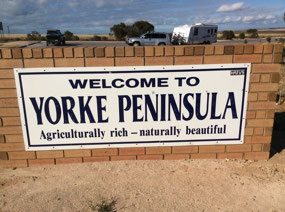
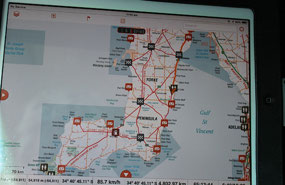
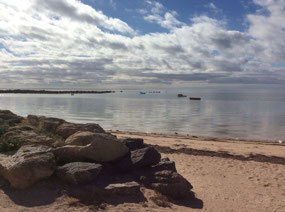
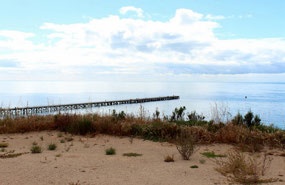
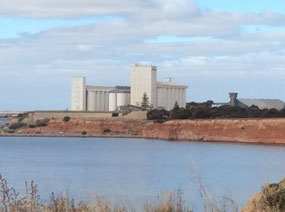
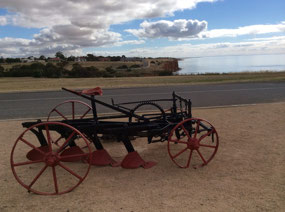
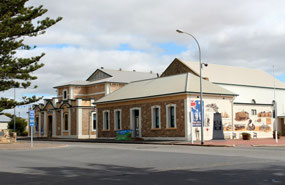
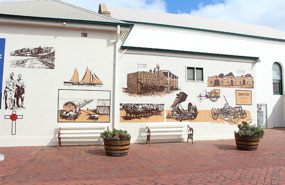
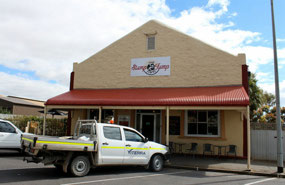
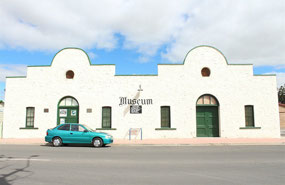
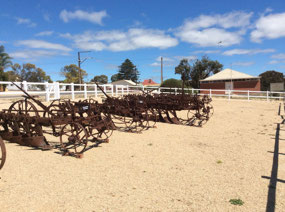
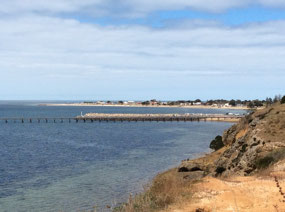

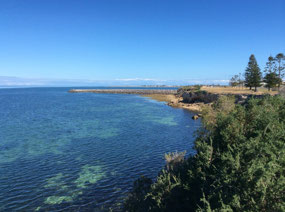
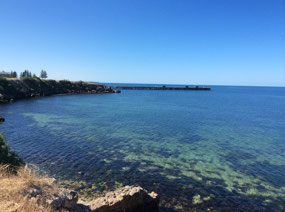
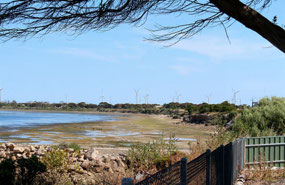
2025-05-22